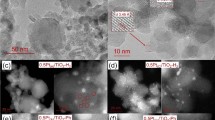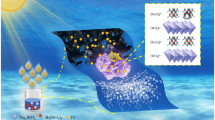Abstract
A nanostructured a-TiO2 (anatase) is well known to be a promising material for harvesting photocatalysis in ultraviolet–visible light for its applications. In this article, we report a simple biosynthesis of a stable compound a-TiO2-C-O of small core–shells by a hydrothermal reaction of titanium tetrabutoxide in small tissues (proteins, lipids, or carbohydrates) of green chili (hot) at moderate temperature followed by burning out the organics in a flame in camphor in open air. In a proposed microscopic model, the a-TiO2 is shown to be growing preferentially in support of an inbuilt biogenic 2D layer C–sp 2 (template) in the coherent (101) facets in a controlled shape of small cuboids (8–15 nm sizes), with a joint C–sp 2 charge/spin layer in an a-TiO2-C-O hybrid composite phase. A thin residual ‘Ti4+ -O-C’ surface layer lasts, with a rocking of a ‘C-O cage’ on the Ti4+ ions of 285 cm−1 frequency, in the samples heated at ≤ 600 °C in air. It is found to be promoting a markedly enhanced photocatalytic response in degrading methylene blue dye and 2-chlorophenol under a visible light irradiation. The results are described with N2 sorption hysteresis, microscopic images, Raman/XPS (X-ray photoelectron spectroscopy) bands, and ultraviolet–visible light absorption/emission spectra in the samples prepared of varied microscopic surface layers.













Similar content being viewed by others
References
Hashimoto K, Irie H, Fujishima A (2005) TiO2 photocatalysis: a historical overview and future prospects. Jpn J Appl Phys 44:8269–8285
Wu L, Yu JC, Wang X, Zhang L, Yu J (2005) characterization of mesoporous nanocrystalline TiO2 photocatalysts synthesized via a sol-solvothermal process at a low temperature. J Solid State Chem 178:321–328
Han S, Choi S-H, Kim S-S, Cho M, Jang B, Kim D-Y, Yoon J, Hyeon T (2005) Low-temperature synthesis of highly crystalline TiO2 nanocrystals and their application to photocatalysis. Small 1:812–816
Zhang R, Tu B, Zhao D (2010) Synthesis of highly stable and crystalline mesoporous anatase by using a simple surfactant sulfuric acid carbonization method. Chem Eur J 16:9977–9981
Zhang J, Zhou P, Liu J, Yu J (2014) New understanding of the difference of photocatalytic activity among anatase, rutile and brookite. Phys Chem Chem Phys 16:20382–20386
Zhang J, Vasei M, Sang Y, Liu H, Claverie JP (2016) TiO2@carbon photocatalysts: the effect of carbon thickness on catalysis. ACS Appl Mater Interfaces 8:1903–1912
Jiang J, Tang X, Zhou S, Ding J, Zhou H, Zhang F, Zhang D, Fan T (2016) Synthesis of visible and near infrared light sensitive amorphous titania for photocatalytic hydrogen evolution. Green Chem 18:2056–2062
Sreethawong T, Suzuki Y, Yoshikawa S (2005) Synthesis, characterization, and photocatalytic activity for hydrogen evolution of nanocrystalline mesoporous titania prepared by surfactant-assisted templating sol-gel process. J Solid State Chem 178:329–338
Fan W, Lai Q, Zhang Q, Wang Y (2011) Nanocomposites of TiO2 and reduced graphene oxide as efficient photocatalysts for hydrogen evolution. J Phys Chem C 115:10694–10701
Hu L, Zeng G, Chen G, Dong H, Liu Y, Wan J, Chen A, Guo Z, Yan M, Wu H, Yu Z (2016) Treatment of landfill leachate using immobilized Phanerochaete chrysosporium loaded with nitrogen-doped TiO2 nanoparticles. J Haz Mat 301:106–118
Zeng G, Wan J, Huang D, Hu L, Huang C, Cheng M, Xue W, Gong X, Wang R, Jiang D (2017) Precipitation, adsorption and rhizosphere effect: the mechanisms for phosphate-induced Pb immobilization in soils-a review. J Haz Mat 339:354–367
Scanlon DO, Dunnill CW, Buckeridge J, Shevlin SA, Logsdail AJ, Woodley SM, Catlow CRA, Powell MJ, Palgrave RG, Parkin IP, Watson GW, Keal TW, Sherwood P, Walsh A, Sokol AA (2013) Band alignment of rutile and anatase TiO2. Nat Mater 12:798–801
Dette C, Perez-Osorio MA, Kley CS, Punke P, Patrick CE, Jacobson P, Giustino F, Jung SJ, Kern K (2014) TiO2 anatase with a bandgap in the visible region. Nano Lett 14:6533–6538
Asahi R, Morikawa T, Ohwaki T, Aoki K, Taga Y (2001) Visible-light photocatalysis in nitrogen-doped titanium oxides. Science 293:269–272
Paola AD, Marci G, Palmisano L, Schiavello M, Uosaki K, Ikeda S, Ohtani B (2002) Preparation of polycrystalline TiO2 photocatalysts impregnated with various transition metal ions: characterization and photocatalytic activity for the degradation of 4-nitrophenol. J Phys Chem B 106:637–645
Graciani J, Nambu A, Evans J, Rodriguez JA, Sanz JF (2008) Au ↔ N synergy and N-doping of metal oxide-based photocatalysts. J Am Chem Soc 130:12056–12063
Zhang LW, Fu HB, Zhu YF (2008) Efficient TiO2 Photocatalysts from surface hybridization of TiO2 particles with graphite-like carbon. Adv Funct Mater 18:2180–2189
Li H, Bian Z, Zhu J, Zhang D, Li G, Huo Y, Li H, Lu Y (2007) Mesoporous titania spheres with tunable chamber structure and enhanced photocatalytic activity. J Am Chem Soc 129:8406–8407
Zhang X-Y, Li H-P, Cui X-L, Lin Y (2010) Graphene/TiO2 nanocomposites: synthesis, characterization and application in hydrogen evolution from water photocatalytic splitting. J Mater Chem 20:2801–2806
Paramasivam I, Jha H, Liu N, Schmuki P (2012) A review of photocatalysis using self-organized TiO2 nanotubes and other ordered oxide nanostructures. Small 8:3073–3103
Hu L, Zhang C, Zeng G, Chen G, Wan J, Guo Z, Wu H, Yu Z, Zhou Y, Liu Z (2016) Metal-based quantum dots: synthesis, surface modification, transport and fate in aquatic environments and toxicity to microorganisms. RSC Adv 6:78595–78610
Li X, Fan T, Zhou H, Chow S-K, Zhang W, Zhang D, Guo Q, Ogawa H (2009) enhanced light-harvesting and photocatalytic properties in morph-TiO2 from green-leaf biotemplates. Adv Funct Mater 19:45–56
Sun D, Yang J, Wang X (2010) Bacterial cellulose/TiO2 hybrid nanofibers prepared by the surface hydrolysis method with molecular precision. Nanoscale 2:287–292
Ismail AA, Bahnemann DW (2011) Mesoporous titania photocatalysts: preparation, characterization and reaction mechanisms. J Mater Chem 21:11686–11707
Joo JB, Zhang Q, Lee I, Dahl M, Zaera F, Yin Y (2012) Mesoporous anatase titania hollow nanostructures though silica-protected calcination. Adv Funct Mater 22:166–174
Wesarg F, Schlott F, Grabow J, Kurland H-D, Heßler N, Kralisch D, Müller FA (2012) In situ synthesis of photocatalytically active hybrids consisting of bacterial nanocellulose and anatase nanoparticles. Langmuir 28:13518–13525
Li J, Chen Y, Wang Y, Yan Z, Duan D, Wang J (2015) Synthesis and photocatalysis of mesoporous titania templated by natural rubber latex. RSC Adv 5:21480–21486
Mullin R (2003) Red-hot chili peppers. C & EN 41:1. https://doi.org/10.1021/cen-v081n044.p041
Conway SJ (2008) TRPing the switch on pain: an introduction to the chemistry and biology of capsaicin and TRPV1. Chem Soc Rev 37:1530–1545
Bhattacharya A, Chattopadhyay A, Mazumdar D, Chakravarty A, Pal S (2010) Antioxidant constituents and enzyme activities in chilli peppers. Int J Veg Sci 16:201–211
Wesolowska A, Jadczak D, Grzeszczuk M (2011) Chemical composition of the pepper fruit extracts of hot cultivars Capsicum annuum L. Acta Sci Hortorum Cultus 10:171–184
Kumar K, Walia S (2012) L-asparaginase extracted from Capsicum annuum L. and development of asparagine biosensor for leukemia. Sens Transducers 144:192–200
Li S, Shen Y, Xie A, Yu X, Qiu L, Zhang L, Zhang Q (2007) Green synthesis of silver nanoparticles using Capsicum annuum L. extract. Green Chem 9:852–858
Kumar SG, Rao KSRK (2014) Polymorphic phase transition among the titania crystal structures using a solution-based approach: from precursor chemistry to nucleation process. Nanoscale 6:11574–11632
Cho KM, Kim KH, Choi HO, Jung H-T (2015) A highly photoactive, visible-light-driven graphene/2d mesoporous TiO2 photocatalyst. Green Chem 17:3972–3978
Perosa A, Selva M (2012) Handbook of Green Chemistry. Wiley-VCH, Weinheim
Ram S, Fecht H (2011) Modulating up-energy transfer and violet-blue light emission in gold nanoparticles with surface adsorption of poly(vinyl pyrrolidone) molecules. J Phys Chem C 115:7817–7828
Misra S, Karan T, Ram S (2015) Dynamics of surface spins in small core-shell magnets of Li0.35Zn0.30Fe2.35O4 bonds over a carbon surface and tailored magnetic properties. J Phys Chem C 119:23184–23195
Mishra A, Ram S (2007) Surface enhanced optical absorption and photoluminescence in nonbonding electrons in small poly(vinyl pyrrolidone) molecules. J Chem Phys 126(084902):1–6
Shen J, Hu Y, Shi M, Li N, Ma H, Ye M (2010) One step synthesis of graphene oxide-magnetic nanoparticle composite. J Phys Chem C 114:1498–1503
X-ray powder diffraction JCPDS file 021-1272 (2013) Joint Committee on Powder Diffraction Standard International Centre for Diffraction Data, Swarthmore, PA, USA
Williamson G, Hall W (1953) X-ray Line Broadening from Filed Aluminium and Wolfram. Acta Metall 1:22–31
Yoon SB, Chai GS, Kang SK, Yu J-S, Gierszal KP, Jaroniec M (2005) Graphitized pitch-based carbons with ordered nanopores synthesized by using colloidal crystals as templates. J Am Chem Soc 127:4188–4189
Yang H, Shan C, Li F, Han D, Zhang Q, Niu L (2009) Covalent functionalization of polydisperse chemically-converted graphene sheets with amine-terminated ionic liquid. Chem Commun 26:3880–3882
Dong F, Guo S, Wang H, Li X, Wu Z (2011) Enhancement of the visible light photocatalytic activity of C-doped TiO2 nanomaterials prepared by a green synthetic approach. J Phys Chem C 115:13285–13292
Yan J-A, Xian L, Chou MY (2009) Structural and electronic properties of oxidized graphene. Phys Rev Lett 103(086802):1–4
Ohsaka T, Izumi F, Fujiki Y (1978) Raman spectrum of anatase, TiO2. J Raman Spect 7:321–324
Dillen DC, Varahramyan KM, Corbet CM, Tutuc E (2012) Raman spectroscopy and strain mapping in individual Ge-SixGe1-x core-shell nanowires. Phys Rev B 86(45311):1–6
Kim IY, Lee JM, Kim TW, Kim HN, Kim H (2012) A strong electronic coupling between graphene nanosheets and layered titanate nanoplates: a soft-chemical route to highly porous nanocomposites with improved photocatalytic activity. Small 8:1038–1048
Colthup NB, Daly LH, Wiberley SE (1990) Introduction to infrared and Raman spectroscopy. Academic Press, London
Jin Z, Meng F-L, Jia Y, Luo T, Liu J-Y, Sun B, Wang J, Liu J-H, Huang X-J (2013) Porous TiO2 nanowires derived from nanotubes: synthesis, characterization and their enhanced photocatalytic properties. Micro Meso Mater 181:146–153
Rashid J, Barakat MA, Pettit SL, Kuhn JN (2014) InVO4/TiO2 composite for visible-light photocatalytic degradation of 2-chlorophenol in wastewater. Environ Technol 35:2153–2159
Mishra A, Ram S (2009) Selective light emission in nonbonding electron transitions in poly(vinyl pyrrolidone) molecules on spin-coating in thin layers. J Phys Chem A 113:14067–14073
Acknowledgements
This work has been financially supported in part by All India Council for Technical Education (AICTE), Government of India.
Author information
Authors and Affiliations
Corresponding author
Ethics declarations
Conflict of interest
The authors declare that they have no conflict of interest.
Rights and permissions
About this article
Cite this article
Rajeswari, P.V., Tiwari, B., Ram, S. et al. A biogenic TiO2-C-O nanohybrid grown from a Ti4+-polymer complex in green tissues of chilis, interface bonding, and tailored photocatalytic properties. J Mater Sci 53, 3131–3148 (2018). https://doi.org/10.1007/s10853-017-1763-5
Received:
Accepted:
Published:
Issue Date:
DOI: https://doi.org/10.1007/s10853-017-1763-5




